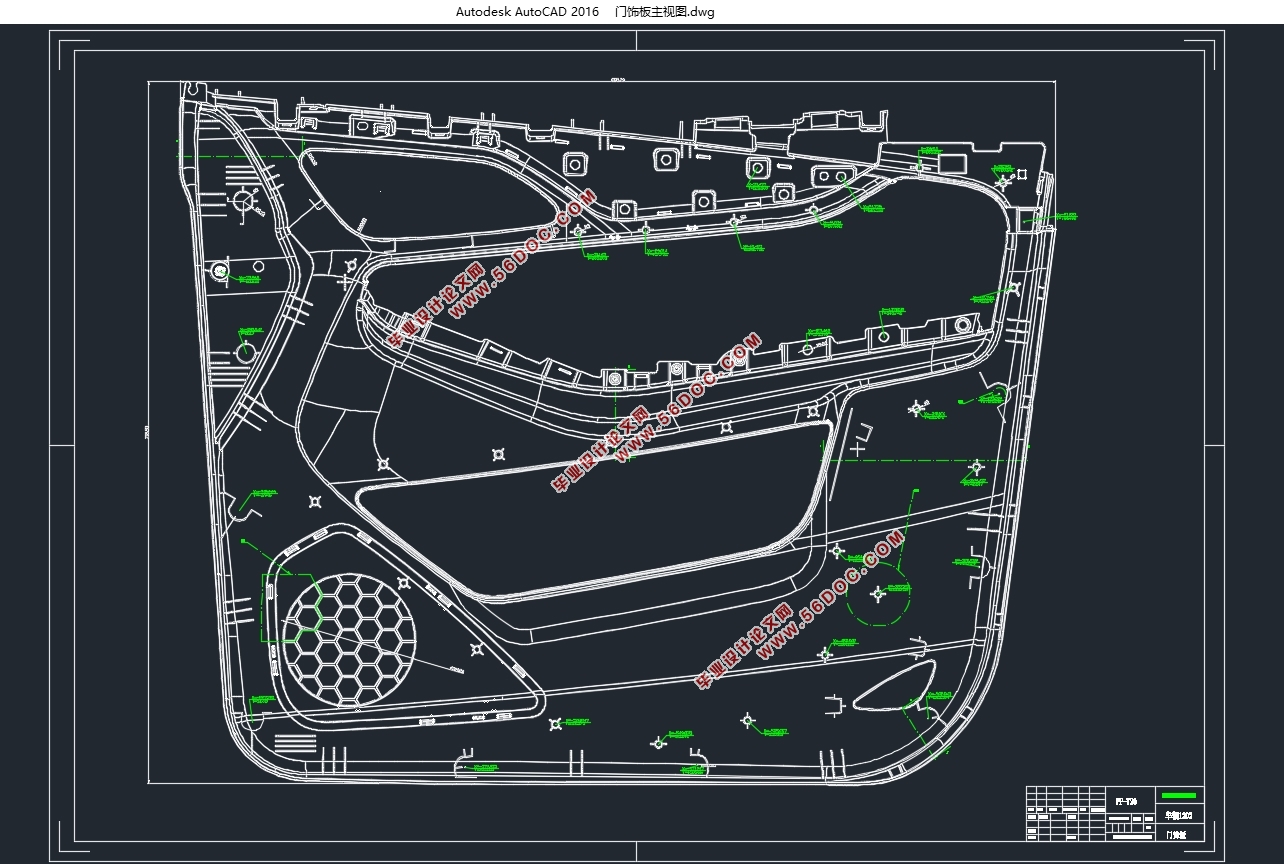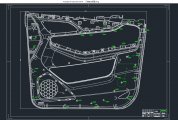汽车门饰板结构设计及性能分析(含CAD图)(任务书,开题报告,文献摘要,论文说明书28000字,CAD图3张)
摘要
在汽车内饰中,门饰板的作用非常重要,它不仅仅是个装饰件和功能件,还可以在车辆发生侧碰时起到缓和冲击、保护乘员的作用。国内外学者对汽车内外饰件的研究领域基本上是内饰件的结构布置、刚度、模态、成型性能、碰撞时的吸能性能、造型等。
本文以老师所给模型为基础,基于CATIA建立了门饰板CAD模型。将模型转化成二维工程图纸,并进行了修改、标注。运用剖视的方法表达出门饰板本体的截面形状,绘制卡扣、Boss柱的局部视图,绘制了喇叭罩区域详细视图。
在Hypermesh软件中创建了门饰板有限元模型。主要对模型进行了几何清理,抽取中面,中面分块,网格划分,网格质量检查,网格优化,OptiStruct、LS-DYNA前处理。
基于Hypermesh的OptiStruct、LS-DYNA模块,对门饰板顶边进行了静强度、刚度分析;对门饰板扶手区域进行了静强度分析,PP-T20材料与ABS材料扶手耐用情况对比分析;对门饰板喇叭罩区域进行了碰撞强度分析,对仿真结果提出了改进意见。
关键词:门饰板、CAD建模、有限元分析、碰撞分析、Hypermesh、CATIA
Abstract
In automotive interior, the role of the door trim is very important, it is not just a decorative element and functional element, it can also serve to ease the impact at the vehicle side impact and protect the occupant. Domestic and foreign scholars generally study automotive interior trim around many aspects, such as structural arrangement, stiffness, modal, molding properties, energy absorption performance of collision、modeling and so on.
This paper is based on the model that the teacher gave, and establishesa CAD model of the door trim through CATIA. Then I transfer the model into two-dimensional engineering drawings, and have it modified、labeled. After that, I expresscross-sectional shape of the trim body, using a method of cross-sectional view, draw a partial view of the snap、Boss column and a detailed view of speaker enclosures region.
I create a door trim finite element model in the Hypermesh software. Have a geometry cleanupfor the main model, and extract the face, block the face, check mesh quality, optimize the mesh, have a pre-treatment through OptiStruct、LS-DYNA。Then I analyze the static strength and stiffness of the top edge in the door trim, which based on OptiStruct and LS-DYNA module of Hypermesh. Comparing PP-T20 materials with ABS material for handrails’ durable case, making a collision strength analysis for the door trim speaker enclosures area, putting forward some improvements suggestion according to the simulation results.
Keywords: door trim, CAD modeling, finite element analysis, collision, Hypermesh,CATIA

目录
摘要 I
Abstract II
第1章绪论 1
1.1 引言 1
1.2 门饰板国内外发展现状 1
1.3 研究目的及意义 3
1.4研究的基本内容 4
1.5研究目标 5
1.6本章小结 5
第2章门饰板CAD建模及工程图的绘制 6
2.1 车门结构介绍 6
2.2 汽车内饰及门饰板介绍 6
2.2.1汽车内饰的介绍 6
2.2.2 门饰板结构介绍 6
2.3 CATIA软件简介 8
2.4 门饰板建模 9
2.4.1 门饰板顶边的建立 10
2.4.2 中饰板模型的建立 11
2.4.3 门饰板中下部区域的建模 12
2.5 门饰板建模经验总结 13
2.6 机械制图的生成 14
2.6.1 主视图的生成 14
2.6.2 门饰板截面剖视图 15
2.6.3 卡扣、Boss柱的局部视图 15
2.6.4 喇叭罩祥视图的生成 16
2.7 AutoCAD软件介绍 16
2.8 标注 17
2.9 本章小结 18
第3章门饰板有限元建模 19
3.1 Altair公司及Hypermesh软件介绍 19
3.2 模型导入 20
3.3 模型的几何清理 20
3.3.1以拓扑方式观察模型并通过渲染检查模型完整性。 20
3.3.2 清除重复曲面 20
3.3.3 CAD清理容差 21
3.3.4 使用toggle工具逐个缝合各个自由边 21
3.3.5 创建面填补模型较大空隙 21
3.3.6 去除面与面之间的倒角 21
3.4 模型中面的获取 22
3.4.1 抽取模型中面 22
3.4.2 几何修复中面 22
3.5 优化中面 23
3.5.1 去除尖角面 23
3.5.2 删除小圆角面重新建模 24
3.5.3 合并合适的共享边为抑制边 26
3.5.4 中面分块 26
3.5.5 消除线上硬点 27
3.6 静力分析网格划分 27
3.6.1 自动划分网格 27
3.6.2 网格优化 28
3.7 碰撞分析网格划分 32
3.7.1 喇叭罩模型简化 32
3.7.2 建立钢球模型 32
3.7.3 QI网格划分 33
3.8 门饰板材料和试验方法的说明 33
3.8.1 Hypermesh单位说明 33
3.8.2 门饰板材料属性 34
3.8.3 碰撞标准和钢球的材料参数 34
3.8.4 门饰板顶边静压强度测试方法 34
3.8.5 扶手最大垂直载荷试验 34
3.9 OptiStruct前处理 35
3.9.1定义门饰板材料参数和属性 35
3.9.2定义边界条件及载荷工况 35
3.10 LS-DYNA前处理 36
3.10.1 定义门饰板、钢球材料参数及属性 36
3.10.2 创建边界条件及钢球速度 37
3.10.3 创建接触面及Group 38
3.10.4 定义输出卡片及文件 38
3.11 本章小结 38
第4章门饰板静压强度、刚度、静强度、碰撞强度分析 39
4.1 顶边的静压强度、刚度分析 39
4.2 扶手最大垂直载荷分析 42
4.2.1 PP-T20材料扶手最大垂直载荷分析 42
4.2.2 ABS与PP-T20材料扶手最大垂直载荷对比分析 44
4.3 喇叭罩碰撞强度分析 47
4.4 本章小结 51
第5章总结和展望 52
5.1 总结 52
5.2 展望 52
参考文献 54
致谢 56
|



